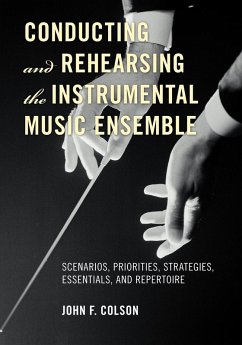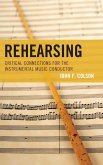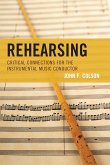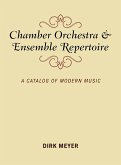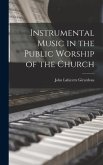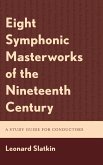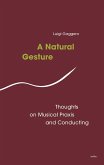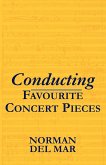John F. Colson
Conducting and Rehearsing the Instrumental Music Ensemble
Scenarios, Priorities, Strategies, Essentials, and Repertoire
John F. Colson
Conducting and Rehearsing the Instrumental Music Ensemble
Scenarios, Priorities, Strategies, Essentials, and Repertoire
- Broschiertes Buch
- Merkliste
- Auf die Merkliste
- Bewerten Bewerten
- Teilen
- Produkt teilen
- Produkterinnerung
- Produkterinnerung
Conducting and Rehearsing the Instrumental Music Ensemble is the most comprehensive guide on the rehearsalprocess for conducting instrumental music ensembles. Ideal for the advanced instrumental music conductor seeking to look beyond basic conducting technique, this work breaks the multidimensional activity of working with an ensemble, orchestra or band into its constituent components.
Andere Kunden interessierten sich auch für
![Rehearsing Rehearsing]() John F. ColsonRehearsing123,99 €
John F. ColsonRehearsing123,99 €![Rehearsing Rehearsing]() John F. ColsonRehearsing75,99 €
John F. ColsonRehearsing75,99 €![Chamber Orchestra and Ensemble Repertoire Chamber Orchestra and Ensemble Repertoire]() Dirk MeyerChamber Orchestra and Ensemble Repertoire119,99 €
Dirk MeyerChamber Orchestra and Ensemble Repertoire119,99 €![Instrumental Music in the Public Worship of the Church Instrumental Music in the Public Worship of the Church]() John Lafayette GirardeauInstrumental Music in the Public Worship of the Church30,99 €
John Lafayette GirardeauInstrumental Music in the Public Worship of the Church30,99 €![Eight Symphonic Masterworks of the Nineteenth Century Eight Symphonic Masterworks of the Nineteenth Century]() Leonard SlatkinEight Symphonic Masterworks of the Nineteenth Century88,99 €
Leonard SlatkinEight Symphonic Masterworks of the Nineteenth Century88,99 €![A Natural Gesture A Natural Gesture]() Gaggero LuigiA Natural Gesture20,00 €
Gaggero LuigiA Natural Gesture20,00 €![Conducting Favourite Concert Pieces Conducting Favourite Concert Pieces]() Norman Del MarConducting Favourite Concert Pieces75,99 €
Norman Del MarConducting Favourite Concert Pieces75,99 €-
-
-
Conducting and Rehearsing the Instrumental Music Ensemble is the most comprehensive guide on the rehearsalprocess for conducting instrumental music ensembles. Ideal for the advanced instrumental music conductor seeking to look beyond basic conducting technique, this work breaks the multidimensional activity of working with an ensemble, orchestra or band into its constituent components.
Produktdetails
- Produktdetails
- Verlag: Scarecrow Press
- Seitenzahl: 520
- Erscheinungstermin: 9. August 2012
- Englisch
- Abmessung: 254mm x 178mm x 28mm
- Gewicht: 967g
- ISBN-13: 9780810882607
- ISBN-10: 0810882604
- Artikelnr.: 35491545
- Herstellerkennzeichnung
- Libri GmbH
- Europaallee 1
- 36244 Bad Hersfeld
- gpsr@libri.de
- Verlag: Scarecrow Press
- Seitenzahl: 520
- Erscheinungstermin: 9. August 2012
- Englisch
- Abmessung: 254mm x 178mm x 28mm
- Gewicht: 967g
- ISBN-13: 9780810882607
- ISBN-10: 0810882604
- Artikelnr.: 35491545
- Herstellerkennzeichnung
- Libri GmbH
- Europaallee 1
- 36244 Bad Hersfeld
- gpsr@libri.de
John F. Colson is professor emeritus of Music at South Dakota State University. He has also been the conductor of the South Dakota State University-Civic Symphony Orchestra for 34 years.
Preface
Part I: The Rehearsal Scenario
Chapter 1: The Rehearsal Scenario: Infrastructure and Process
Chapter 2: Creating the Rehearsal Environment and Climate
Chapter 3: The Ten Essentials of the Rehearsal Process Scenario
Part II: The Conductor In The Rehearsal Process
Chapter 4: Conducting Technique
Chapter 5: Score Study, Music Imagery and Inner Singing
Chapter 6: Rehearsal Segments and Procedures
Chapter 7: An Integrated Approach to Rehearsing
Part III: Technical Priorities And Teaching Strategies
Chapter 8: Intonation and Tuning
Chapter 9: Rhythms and Rhythm Patterns
Chapter 10: Ensemble Sonority: Tone, Balance, Blend, Color and Texture
Chapter 11: Articulation and Bowing
Part IV: Musical Priorities And Teaching Strategies
Chapter 12: Tempo and Ensemble Precision
Chapter 13: Phrasing and the Musical Line
Chapter 14: Style and Musical Interpretation
Chapter 15: Dynamics, Nuances and Musical Expression
Part V: The Conductor In The 21st Century
Chapter 16: Conducting and Rehearsing Contemporary Music
Chapter 17: Conductor Profile and Self-Evaluation
Chapter 18: From Rehearsal Process to Concert Performance
Appendix A: Score Study and Program Building with Standard Repertoire
[Online]
Appendix B: An Outline of Conducting and Rehearsing Problems
Appendix C: An Outline of Technical Problems Encountered in the Ensemble
Rehearsal Process
Appendix D: Instrumental Techniques, Intonation Problems/Solutions and
Special Effects for Individual Instruments plus Contemporary Music Special
Effects and the Notation Bibliography
Appendix E: Conducting/Rehearsing Videos Recommended
Appendix F: Student Project Evaluations (Conducting/Rehearsing)
Appendix G: Listening and Score Study Analysis Assignment Forms
Addendum I: Creating a Rehearsal Process (Lab) Environment in the
Conducting Curriculum
Addendum II: Possible Class Activities, Discussions, Demonstrations,
Projects and Assignments for Advanced Conductors
Bibliography
About the Author
Part I: The Rehearsal Scenario
Chapter 1: The Rehearsal Scenario: Infrastructure and Process
Chapter 2: Creating the Rehearsal Environment and Climate
Chapter 3: The Ten Essentials of the Rehearsal Process Scenario
Part II: The Conductor In The Rehearsal Process
Chapter 4: Conducting Technique
Chapter 5: Score Study, Music Imagery and Inner Singing
Chapter 6: Rehearsal Segments and Procedures
Chapter 7: An Integrated Approach to Rehearsing
Part III: Technical Priorities And Teaching Strategies
Chapter 8: Intonation and Tuning
Chapter 9: Rhythms and Rhythm Patterns
Chapter 10: Ensemble Sonority: Tone, Balance, Blend, Color and Texture
Chapter 11: Articulation and Bowing
Part IV: Musical Priorities And Teaching Strategies
Chapter 12: Tempo and Ensemble Precision
Chapter 13: Phrasing and the Musical Line
Chapter 14: Style and Musical Interpretation
Chapter 15: Dynamics, Nuances and Musical Expression
Part V: The Conductor In The 21st Century
Chapter 16: Conducting and Rehearsing Contemporary Music
Chapter 17: Conductor Profile and Self-Evaluation
Chapter 18: From Rehearsal Process to Concert Performance
Appendix A: Score Study and Program Building with Standard Repertoire
[Online]
Appendix B: An Outline of Conducting and Rehearsing Problems
Appendix C: An Outline of Technical Problems Encountered in the Ensemble
Rehearsal Process
Appendix D: Instrumental Techniques, Intonation Problems/Solutions and
Special Effects for Individual Instruments plus Contemporary Music Special
Effects and the Notation Bibliography
Appendix E: Conducting/Rehearsing Videos Recommended
Appendix F: Student Project Evaluations (Conducting/Rehearsing)
Appendix G: Listening and Score Study Analysis Assignment Forms
Addendum I: Creating a Rehearsal Process (Lab) Environment in the
Conducting Curriculum
Addendum II: Possible Class Activities, Discussions, Demonstrations,
Projects and Assignments for Advanced Conductors
Bibliography
About the Author
Preface
Part I: The Rehearsal Scenario
Chapter 1: The Rehearsal Scenario: Infrastructure and Process
Chapter 2: Creating the Rehearsal Environment and Climate
Chapter 3: The Ten Essentials of the Rehearsal Process Scenario
Part II: The Conductor In The Rehearsal Process
Chapter 4: Conducting Technique
Chapter 5: Score Study, Music Imagery and Inner Singing
Chapter 6: Rehearsal Segments and Procedures
Chapter 7: An Integrated Approach to Rehearsing
Part III: Technical Priorities And Teaching Strategies
Chapter 8: Intonation and Tuning
Chapter 9: Rhythms and Rhythm Patterns
Chapter 10: Ensemble Sonority: Tone, Balance, Blend, Color and Texture
Chapter 11: Articulation and Bowing
Part IV: Musical Priorities And Teaching Strategies
Chapter 12: Tempo and Ensemble Precision
Chapter 13: Phrasing and the Musical Line
Chapter 14: Style and Musical Interpretation
Chapter 15: Dynamics, Nuances and Musical Expression
Part V: The Conductor In The 21st Century
Chapter 16: Conducting and Rehearsing Contemporary Music
Chapter 17: Conductor Profile and Self-Evaluation
Chapter 18: From Rehearsal Process to Concert Performance
Appendix A: Score Study and Program Building with Standard Repertoire
[Online]
Appendix B: An Outline of Conducting and Rehearsing Problems
Appendix C: An Outline of Technical Problems Encountered in the Ensemble
Rehearsal Process
Appendix D: Instrumental Techniques, Intonation Problems/Solutions and
Special Effects for Individual Instruments plus Contemporary Music Special
Effects and the Notation Bibliography
Appendix E: Conducting/Rehearsing Videos Recommended
Appendix F: Student Project Evaluations (Conducting/Rehearsing)
Appendix G: Listening and Score Study Analysis Assignment Forms
Addendum I: Creating a Rehearsal Process (Lab) Environment in the
Conducting Curriculum
Addendum II: Possible Class Activities, Discussions, Demonstrations,
Projects and Assignments for Advanced Conductors
Bibliography
About the Author
Part I: The Rehearsal Scenario
Chapter 1: The Rehearsal Scenario: Infrastructure and Process
Chapter 2: Creating the Rehearsal Environment and Climate
Chapter 3: The Ten Essentials of the Rehearsal Process Scenario
Part II: The Conductor In The Rehearsal Process
Chapter 4: Conducting Technique
Chapter 5: Score Study, Music Imagery and Inner Singing
Chapter 6: Rehearsal Segments and Procedures
Chapter 7: An Integrated Approach to Rehearsing
Part III: Technical Priorities And Teaching Strategies
Chapter 8: Intonation and Tuning
Chapter 9: Rhythms and Rhythm Patterns
Chapter 10: Ensemble Sonority: Tone, Balance, Blend, Color and Texture
Chapter 11: Articulation and Bowing
Part IV: Musical Priorities And Teaching Strategies
Chapter 12: Tempo and Ensemble Precision
Chapter 13: Phrasing and the Musical Line
Chapter 14: Style and Musical Interpretation
Chapter 15: Dynamics, Nuances and Musical Expression
Part V: The Conductor In The 21st Century
Chapter 16: Conducting and Rehearsing Contemporary Music
Chapter 17: Conductor Profile and Self-Evaluation
Chapter 18: From Rehearsal Process to Concert Performance
Appendix A: Score Study and Program Building with Standard Repertoire
[Online]
Appendix B: An Outline of Conducting and Rehearsing Problems
Appendix C: An Outline of Technical Problems Encountered in the Ensemble
Rehearsal Process
Appendix D: Instrumental Techniques, Intonation Problems/Solutions and
Special Effects for Individual Instruments plus Contemporary Music Special
Effects and the Notation Bibliography
Appendix E: Conducting/Rehearsing Videos Recommended
Appendix F: Student Project Evaluations (Conducting/Rehearsing)
Appendix G: Listening and Score Study Analysis Assignment Forms
Addendum I: Creating a Rehearsal Process (Lab) Environment in the
Conducting Curriculum
Addendum II: Possible Class Activities, Discussions, Demonstrations,
Projects and Assignments for Advanced Conductors
Bibliography
About the Author

